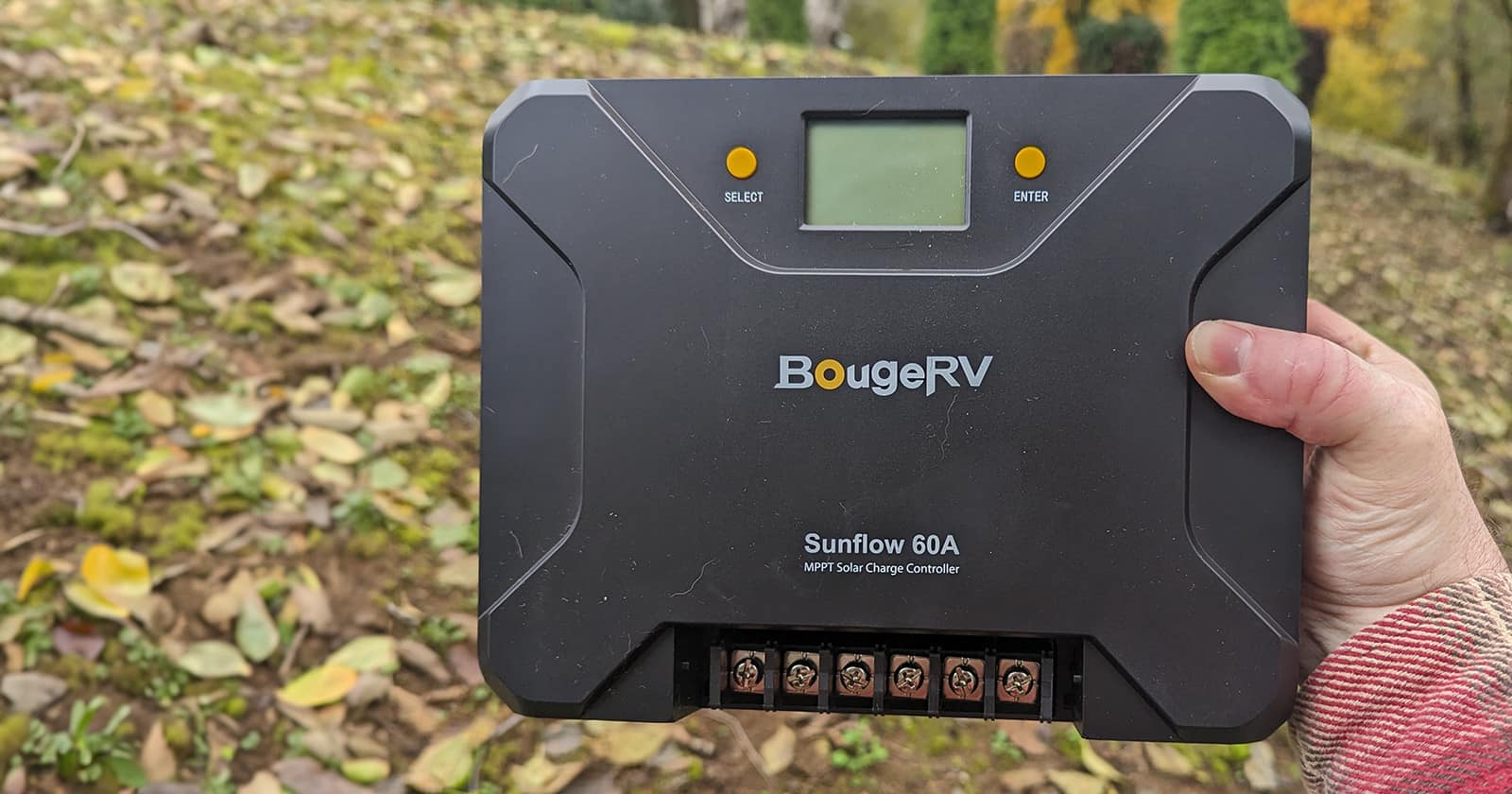Over the past 10 years, solar panel technology has become more affordable to consumers. As a result, many people have found the idea of adding solar power to their RVs appealing. It has allowed them to travel farther “off the grid” and stay out longer drydocking.
If you are considering making the leap to solar panel technology there are some things you need to know before you start. Most people first ask, how much solar power do I need for my RV? The answer is as unique as fingerprints.
Power and Panels
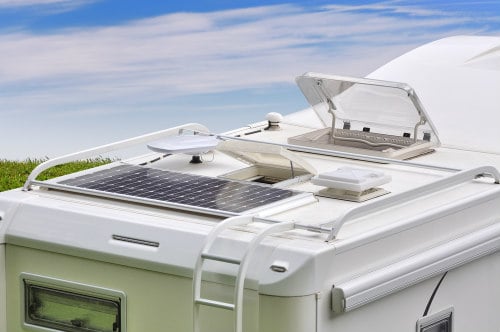
Determining how many solar panels you need for your RV depends on your daily electrical usage. One key factor you need to understand is that your solar panels do not run anything in your RV. What they actually do is recharge your house batteries.
When you ask, “How much solar power do I need for my RV,” what you really need to ask is, “how many solar panels do I need to keep my batteries from running dry?”
Amps, Volts, and Watts
Before we go any further, you first have to understand what each electrical measurement means and what it does for your electrical system.
Volts: Volts measure how strong the electrical current runs through the wires from one point to the other. An example of volts would be pushing your child’s car toy on a flat surface. If it is a longer track, once you release the toy, you will see it slow down the further it goes. Same thing with electricity. With your solar panels, if they have a weak voltage, then your batteries will take longer to charge than if they had a strong voltage.
- VERSATILE DIGITAL MULTIMETER - Accurately measures AC/DC Voltage,...
- TROUBLESHOOTING WITH ACCURACY - This Multimeter has a sampling...
- ENSURES SAFETY - Double ceramic fuse is anti-burn and protects...
- EASE OF USE - Support Data Hold, low battery indicator and...
- ADDITIONAL TIPS - This Multimeter is designed to troubleshoot a...
Watts: Watts measure the rate at which power is being used. A good analogy for watts is the volume of water that comes out of a hose. Watts is a measurement of how many gallons per minute are flowing out of the hose.
Let’s say you have a garden hose with a water pressure of 120 psi (instead of 120 volts). When you turn the water on all the way, this imaginary hose can put out 3000 gallons per minute (watts). That would be an impressive hose, but you get the idea.
Amperage (Amp): Amps measure the amount of electrical current. It’s kind of like the speed of the electricity. In the water analogy, it would be just that, the speed at which the water moves through the hose at 120 psi (volts) to pump out 3000 gallons per minute (watts).
All of the above measurements are related to each other. If the water pressure drops, you need more amps (faster speed) to have the same amount of water flow out of the hose (watts).
- 【2000 Counts 8233D PRO Pocket Digital Multimeter】 Neoteck...
- 【Included 9 Volt Battery】The Compartment Lid at the Back is...
- 【CE Rated Digital Multimeter with Over Load Protection】This...
- 【Large Backlit LCD Display】What’s More, this Voltage Meter...
- 【Nice Protective Orange Shell with Stand Built】The Case with...
Amp-Hours (Ah): The Ah rating is usually used on batteries and is a measurement of the battery’s power capacity. Just like the name implies, Amp-hours is the number of amps that the battery can provide for one hour. Think of it as the gas tank size and mpg rating for the battery.
Like mpg ratings for cars, keep in mind that this number often assumes perfect conditions and may vary slightly in the real world. A 100Ah battery will provide 10 amps of continuous power for 10 hours in perfect conditions.
Watt-Hours (Wh): If watts are a measurement of power, you can guess that watt-hours are a measurement of power used over time. In other words, watt-hours measure the amount of energy used or expended.
Math and Inverters
Batteries and solar panels provide DC power. If you want to run any 120V AC appliances, you will need to use an inverter to convert the DC to AC. To figure out how much power will drain from your batteries, you will have to do a bit of conversion to go from AC to DC power. First, it’s good to know a few formulas. Don’t let the word formula scare you. If you can multiply and divide, you are good to go.
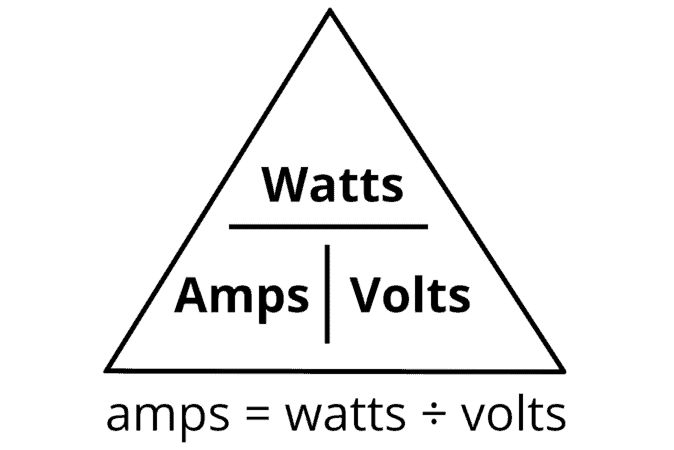
Watts = Amps X Volts
Amps = Watts / Volts
Volts = Watts / Amps
Solar panels are usually rated by how many watts they put out. So you need to know how watts convert into amps. This will help you determine how big your battery bank needs to be and how many or what size solar panels you need.

Let’s take the device above, for example. At 120V, it uses 0.4A. To figure out how many amps it would take to run it with a 12V DC battery, just plug the numbers into the amps formula.
First, let’s find out how many watts our 120V appliance uses.
120V X .4A = 48W
Now we plug the 12.6 volts (voltage of a full 12V battery) of our battery into the amps equation.
48W / 12.6V = 3.8A
So this fan that uses 0.4A on AC will use about 3.8A on DC with an inverter, sort of. There are some factors we have to take into account when using an inverter to run AC appliances with a DC battery.
Adding the Inverter
In the world of energy, nothing is free. The device that converts your batteries’ DC power into AC power to run your 110V/120V devices is called an inverter. It is not 100% efficient. The conversion process causes energy loss in the form of heat. It depends on the efficiency of your inverter, but the loss ranges from 10%-15%. It, therefore, requires more battery power to make up for the energy loss.
To take into account the loss, the formula to find 12V DC amps from 120V AC amps is (Watts / Volts) / 0.85 (to account for the power loss) = Amps. So let’s figure in the loss for the equation above.
(48W / 12.6V) / 0.85 = Amps
3.8 / 0.85 = 4.47 Amps
So our approximate amp draw is 4.47 amps to run that fan off the battery with an inverter.
Let’s say you run the fan that takes 4.47A and run it for 4 hours. You could then say you used 17.88 amp-hours from your battery. If that battery was a 100Ah lithium-ion battery, you would have about 82Ah left.
As a note, if you are calculating amp usage of 12V devices like lights, gas-powered fridges, or propane furnace fans, you do not need to add the power loss. 12V devices don’t have to go through the inverter.
Finding Your Amp-Hour per Day Figure
There are a few methods you could use to estimate your Ah usage. The first would be to find out how many Ah you currently have in your setup. Take your RV boondocking. Make sure your batteries are charged. Turn off everything that charges them (no generator or existing solar panels), and camp-like normal. Keep checking the voltage of your battery until it reaches about 12.2 volts. You could use a multimeter for this if your RV panel doesn’t already display voltage.
At 12.2 volts, your battery is about 50% discharged. You don’t want to typically run your batteries below 50% to prolong their life (if they are lead-acid). Now that you know how long it takes for you to burn through 50% of your batteries, you can figure out how many Ah you used.
For example, imagine you have two house batteries that have a rating of 100 amp-hours each. That is 200 Ah. Let’s say it took you 17 hours to use 50% of the batteries. That’s 100 Ah in 17 hours or 5.8Ah per hour. Multiplying that out to 24 hours gives you about 140Ah per day. It may be a good idea to do this several times to get an average.
The above method will give you a good real-world estimate of amp-hour usage assuming your batteries are new and functioning properly. If your batteries are not in tip-top shape, this method will be skewed a little bit and give a false reading. It also assumes you already have an inverter that you can use to power the 120V appliances off the batteries that you want to while boondocking.
Another common method people use is to manually estimate their amp-hour usage. Write down all of the devices you intend to use by the number of watts they take and the amount of time per day you intend to use them. Multiplying those two numbers will give you the watt-hours per day for that device.
To convert to 12V DC amp-hours, divide the watt-hours by the voltage (12.6 or 12.8 depending on battery type).
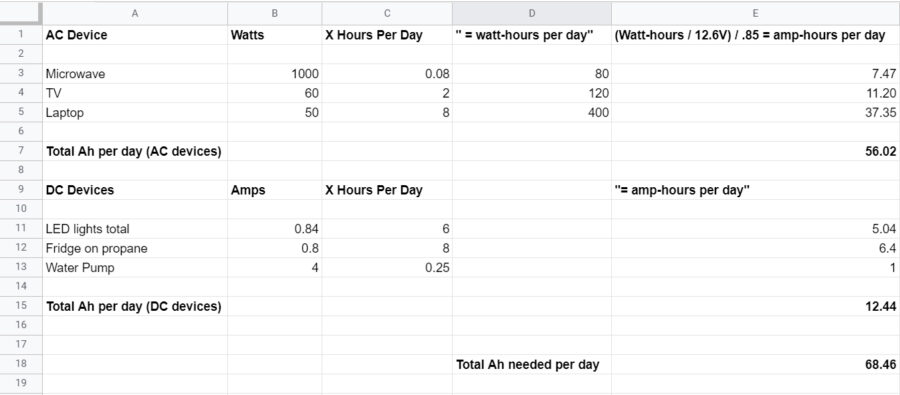
The third and most hands-off method to finding out how much power you use is an online calculator. Many companies that sell solar panels have various calculators that help you find your power usage and the right products to complete your solar system. Go Power! Has a great solar calculator geared for RVers, and Samlex has a handy chart to help find the solar size for you.
- Solar power bank portable charger uses strong professional ABS...
- Portable charger is compatible with all USB devices such as...
- Solar charger power bank has a large battery capacity of...
- Solar phone charger is equipped with a super bright LED...
- Friendly reminder: When the solar panel is being cared for, it...
Matching Your Panels to Your Amp-Hours

Now that you know your amp-hours per day, you need to determine how many panels you will need. The general rule of thumb with 100-watt solar panels is that they can produce about 30 Ah per day.
There are a number of variables you have to take into account before you order your panels and equipment. There are many things that can decrease the efficiency of your panels.
– Dust in the air
– Dirt on your panels
– The weather (cloud cover, rain, etc)
– Indirect sunlight due to shade
– Panels not being directly pointed at the sun
– Temperature (the hotter the panel is, the less efficient it is)
To achieve peak efficiency, your RV would have to be in lab-like conditions that are almost impossible to reproduce out in the world.
The important thing to remember is that your battery capacity must match your charging potential. Etrailer has a good tip for determining if your battery bank is the appropriate size.
“If you can’t even make it through a day without draining your battery, consider adding to your RV’s battery bank. All the solar panels in the world won’t help if you don’t have enough battery capacity to store the power you require. Ideally, you should be able to go at least 2-3 days before your battery is depleted.”
–etrailer
Equipment Needed for Solar Power
To install your panels correctly and have them do what they are supposed to do, you will need additional devices to make it work.
Batteries: You want your house batteries to be deep cycle batteries (Group 25, 27, etc). They can be lead-acid or lithium-ion. Lithium-ion batteries have the advantage of being able to be discharged 100% allowing you to use more of the Ah rating of the battery. They are more expensive though.
Power Inverter: This device converts your battery power to your household AC power. Your RV may already have one of these for your house batteries. You may have to upgrade it to handle larger power outputs if you increase your battery bank.
- BESTEK Advantage: America's leading power inverter brand....
- Fast Charging: two 110V AC outlets for charging larger devices...
- Ultra Compact and Lightweight: iPhone-sized design ideal for use...
- Multi-Protection: built-in 40 amps fuse to protect your device....
- Durable metal housing provides advanced protection from drops and...
Battery Monitoring System: Some older RVs have a light up bar that goes from green to red. One that gives you actual numbers can give you more accurate readings.
- 【1% Accuracy Measurement】Shunt-type monitor design provides...
- 【Protect the batteries】With High and low capacity alarm...
- 【Fit for all battery】The batter tester is compatible with...
- 【Easy To read】Displays multiple electronic parameters,...
- 【Easy to Install】Transparent shunt holder makes the battery...
Solar Charge Controller: This device manages the charge going into your batteries from the panels themselves. There usually is a diode on the panels that prevent the electricity from reversing direction. If this diode is not properly in place, you could destroy your solar panels.
- UPGRADED SOLAR PANEL CONTROLLER: Compatible with 12V 24V...
- SAFE TO USE: Equipped with overcurrent protection, short-circuit...
- PLEASE NOTE: The charge regulator is only suitable for lead-acid...
- LCD DISPLAY: Let you know the status and data with LCD Display....
- WARRANTY: 12-month warranty and lifetime technique support. If...
Other Ways to Charge Your Batteries
The ideal situation for your solar panels are to be stationary for a long period of time in direct sunlight. Your RV may have other sources of power already equipped.
Installed Generator: Most motorhomes have a built-in generator that can charge your batteries while you are using your electronic devices. The more devices that are using the generator, the less is going toward your batteries
Alternator: Newer motorhomes have a second alternator installed for the purpose of charging your house batteries. Older RVs may only have one, but the alternator charges both the engine and house battery banks.
Shore Power: When you are plugged into a campground or your home’s grid, like your generator, it is charging your batteries while running your electrical devices.
Is Solar Power Worth Having
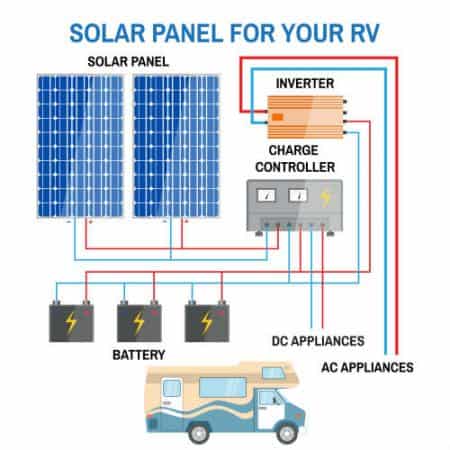
While solar panels are becoming more affordable, you can still expect to pay out in the early four-figures to get everything set up. If your RV has house batteries, part of the system is already set up. Also, newer coaches now have solar panel plugs where you can plug in portable panels that sit on tripods.
If your RV isn’t prewired, installation can still be done yourself. Do your research before you get started. You are dealing with electricity and you are going to be drilling into your RV’s shell.
The good thing about solar power is that there isn’t much maintenance required. The panels are built to take road conditions and there are not any moving parts that wear down. Your biggest concern would be making sure your system is wired correctly to prevent burn outs.
- [Wide Application]: Daily Output 800wh/day under 4 hours full...
- [Excellent Performance]: ECO-WORTHY solar panels use...
- [Durable]: Corrosion-resistant aluminum alloy frame, so that the...
- [Complete and Easy]: The back of the pre-drilled and...
- [Warranty]: 1 year with 24/7 tech support, if any problems or...
Once set up, the advantages can be worth it. Your neighbors will appreciate you not having to turn on your generator. Also, your dry dock experience can go as long as your water tanks hold out. With your panels recharging your batteries everyday, electricity is no longer a concern. For campgrounds that have different levels of campsites, from just a place to set up to a full hook up situation, you can save money by parking on the less expensive raw site.
Product data was last updated on 2024-04-23 at 13:01.

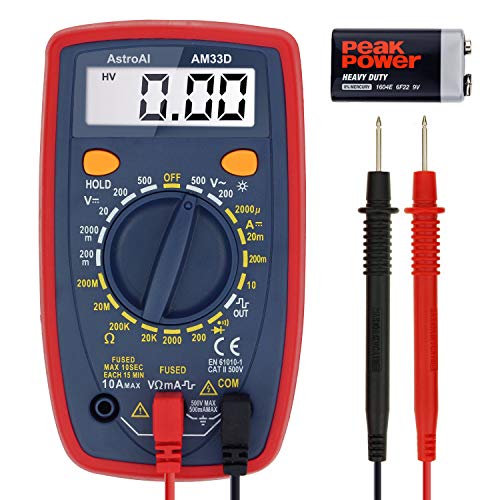




![[Upgraded] 30A Solar Charge Controller, Black Solar Panel Battery Intelligent Regulator...](https://m.media-amazon.com/images/I/41M0gMi3O2L.jpg)


